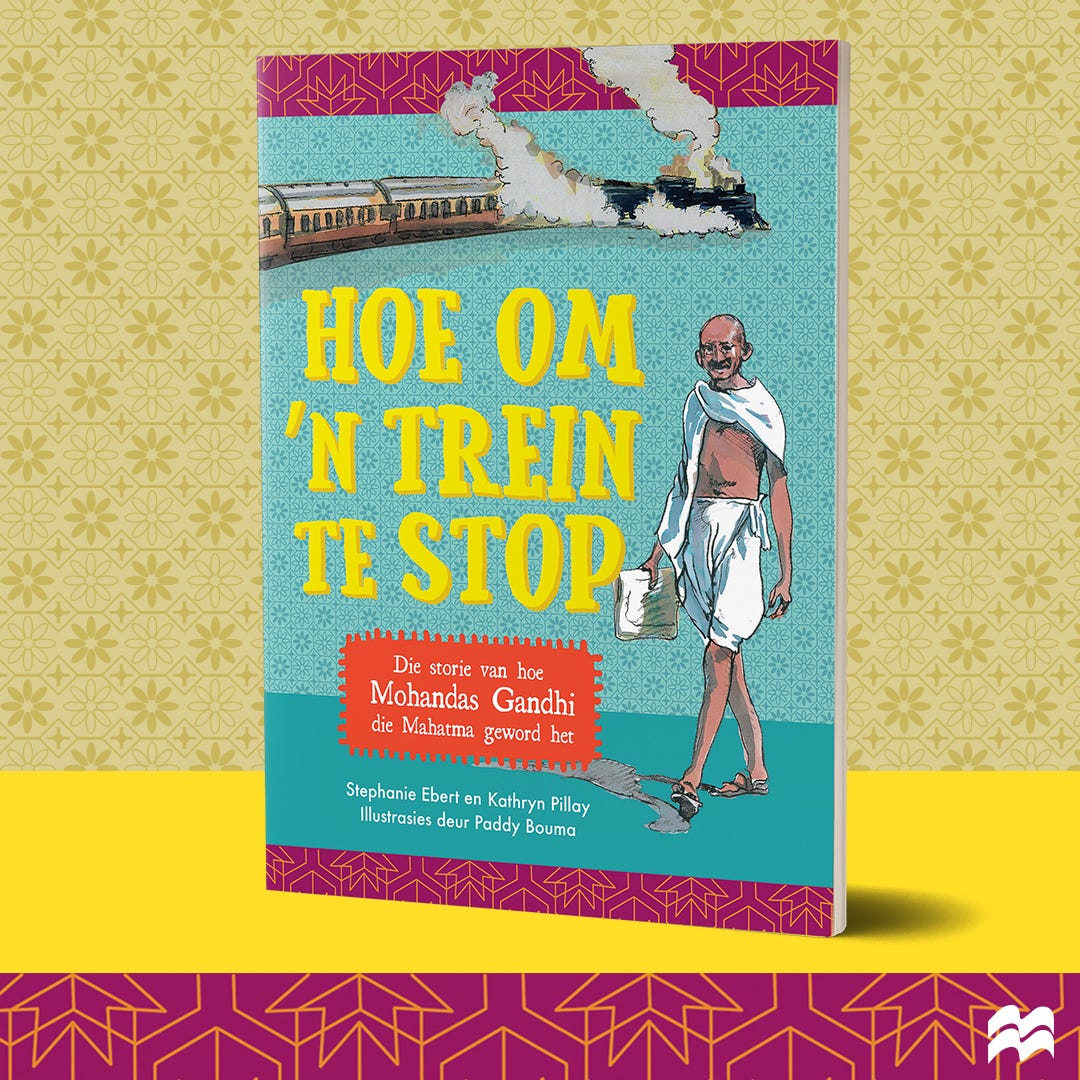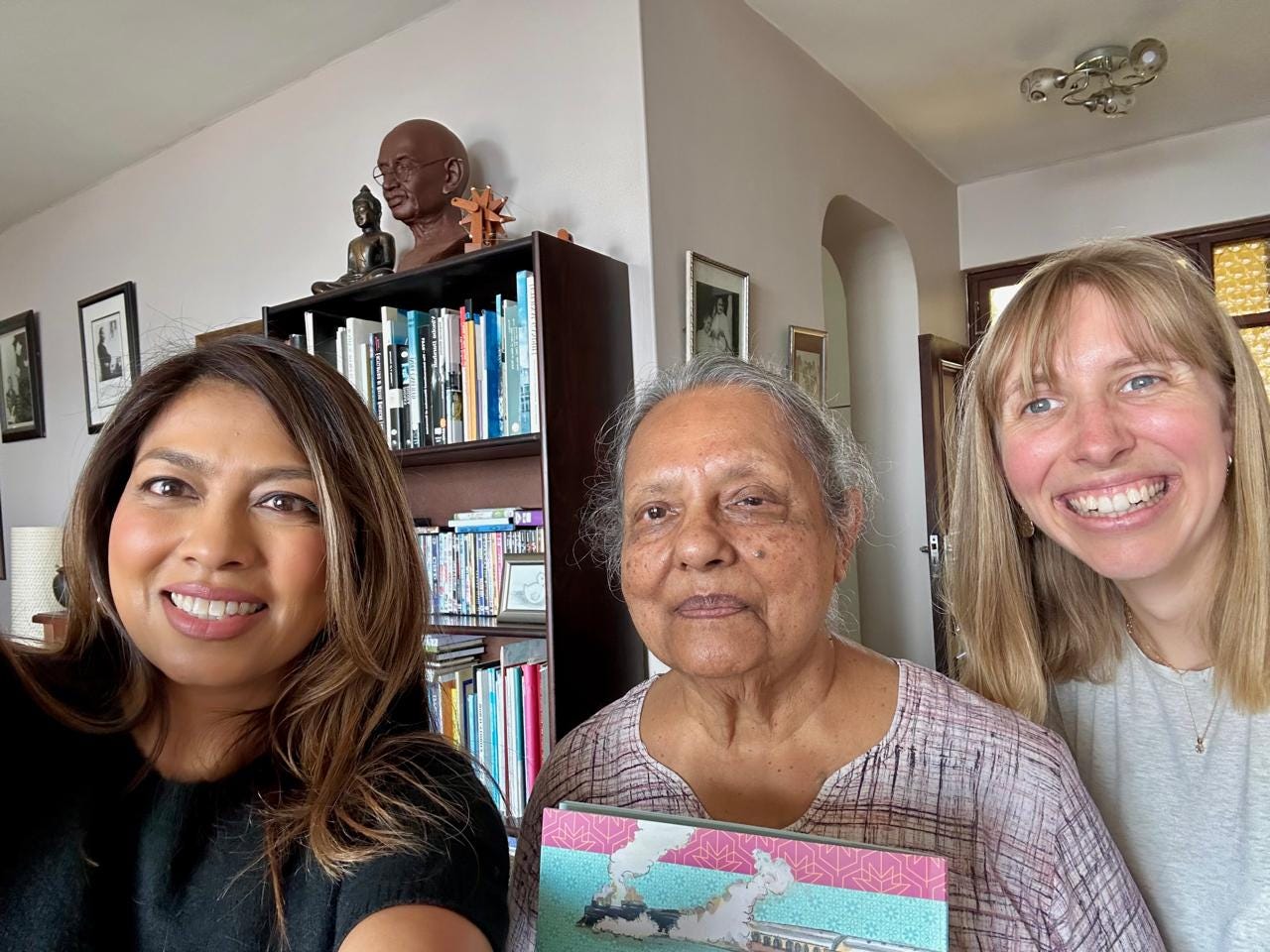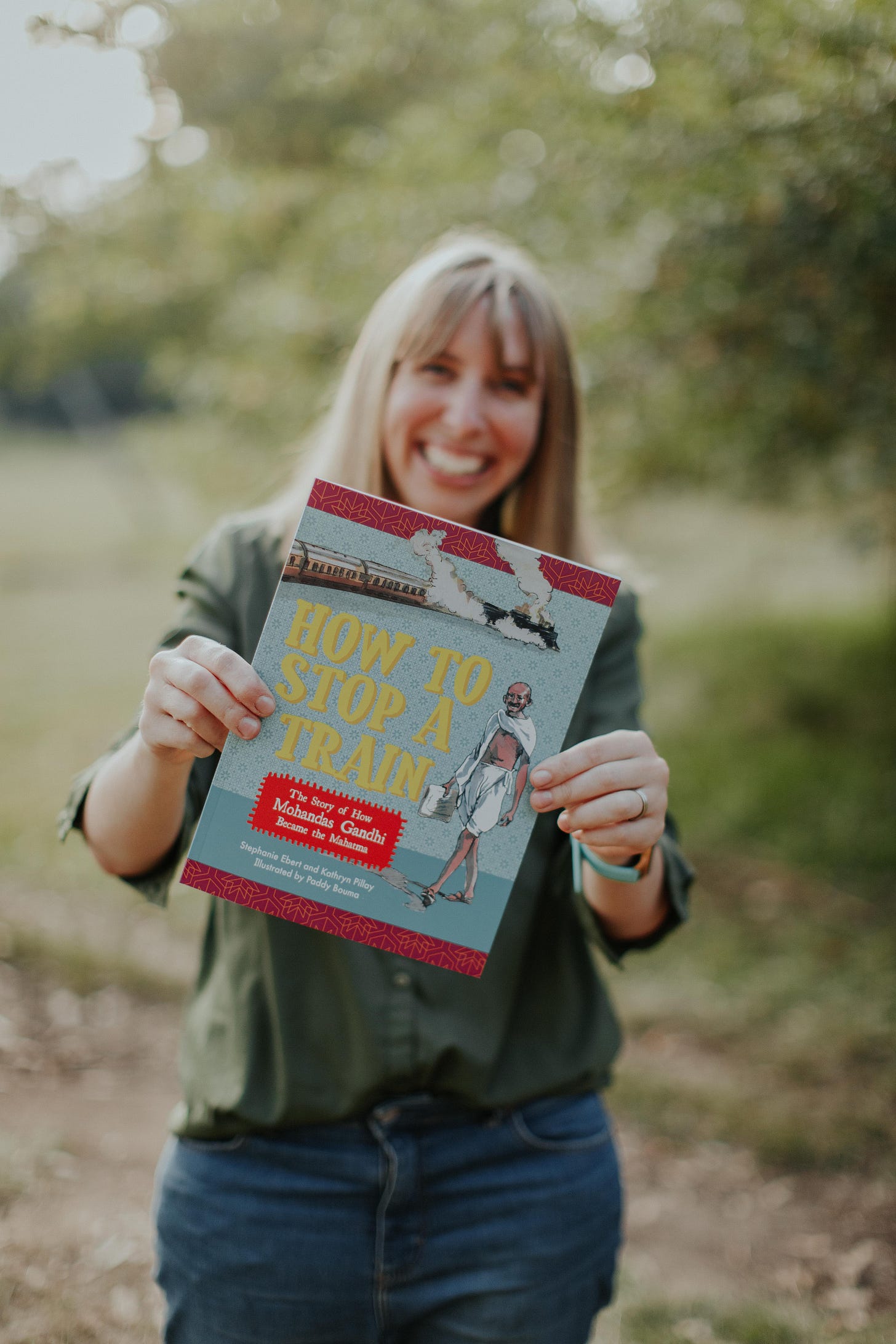The one about the book : How to Stop a Train is here!
On a childhood of books, writing a historical picture book about South African history & meeting Gandhi's granddaughter!
Welcome to Just Beautiful, a newsletter about looking for places where beauty and justice meet. Often this newsletter turns into Louisa May Alcott quotes (she was a social revolutionary, friends), essays on liturgical living in the Southern Hemisphere, and the spiritual implications of children’s literature. This letter is a little different today because my picture book is out!
I am eight. It’s the beginning of the school holidays. I leap out of bed and dash down the hallway to inspect my spot at the breakfast table. I’m not disappointed. Just like every holiday, there is a stack of books sitting next to my place. They are a mix of picture books and early chapter books at exactly my reading level. They are either Caldecott Winners, or Newbery Honor books — or if they aren’t technically award winners, they should be.
Thanks to a little old lady in America who was a children’s librarian and my mom’s passion for books, we received a mailbag of books every year. My mom carefully saved them in her “secret” (not-so-secret) cupboard above her desk, and pulled out a few that fit our age and interests at the start of every holiday. South African kids have a quarterly school system, so if you’re counting, that’s four times a year we got a new stack of books.
History quickly became one of my favorite subjects, not because I loved memorizing dates, but because I wanted to be Kit in The Witch of Blackbird Pond, or Anne in Anne of Green Gables. I devoured the Dear America series of historical fictional diaries of girls set throughout US history. Mixed in with these chapter books were picture books - biographies of famous people from history, or stories like Ruby Bridges or Pink and Say by Patricia Polacco.
It was strange, though. In primary school, we learned about Egyptians and Medieval times and the Khoi San people of South Africa. But we didn’t read any stories about them. We had school projects, we checked books of facts out of the library. But there was no adventure, no danger, no sadness or joy.
__
I am in about fifth grade, frozen in my desk, and watching a painful interaction unfold. “Excuse me!” the teacher snaps at the boy who has forgotten his homework. “Look at me when I’m speaking! Speak up!” “Sorry, Mrs. Taylor,” the boy almost whispers, even softer, and looks down at his feet. “He’s not being rude!” I want to say. I know from growing up in Zulu church that the boy is trying to be polite and humble by talking softly and looking down. But to the white South African teacher, his mumbling is disrespectful.
It reminds me of a book that I found in a public library when we were visiting America the year before. The story of Pocahontas (I think!). I picked it up because Pocahontas was clearly the best Disney princess. I read the story of the early interactions between Native Americans and white settlers, but when I started the story the main character was one of the children of the white settlers. Then, I had to flip the book over, and read the same story, but from the perspective of the Native American children. It kind of blew my fourth-grader mind. (Especially flipping the book over. I mean! What! And it was exactly the same events, but a completely different story). Watching the teacher and the student in my class, I wanted to freeze the moment, like pressing pause on a VHS tape. I wanted give them a minute, let them step outside of themselves, and climb into each other’s skin. I wanted them to see through the other person’s eyes for a few minutes. I wanted them to read the story, flip it over, then read it the other way.
___
We didn’t really learn South African history until high school. And then, there were no picture books. No novels. I drove around on streets named after Chris Hani or Bram Fischer, but didn’t learn who they were until grade 11, and even then they were just names in a textbook to cram for an exam.
Fast-forward to 18-year-old me, sitting with my legs crammed under a college desk in the musty-smelling English Department of the small university I went to. The handful of exceptionally nervous freshman English majors are going around the circle, saying why we picked English for a major, and “what we want to do with it” when we’re done. Amid aspiring journalists, English teachers, and college professors, there was big imposter syndrom energy. I remember having no real idea “what I wanted to do” with an English degree.
No one had told me about Charlotte Mason’s view of living books. I didn’t have any grand theories of education. But I knew that I loved history because of the stories. That I laughed and cried and hoped and raged for America and all that it promised to be in the world, despite growing up in another country, because of the stories. And I was sad that I didn’t get to do that with my birth-place, South Africa. I was sad that my South African friends had never had the experience of imagining they were someone else, on another side of a historical fault-line, because of a gripping story. I was sad that things like the beauty and pain of other cultures in our country were hidden from each other. I wondered if maybe we we’d run out of “fight” for things like economic equality and ending poverty and racially diverse churches, only because we hadn’t yet fallen in love with the thing we were fighting for.
So when it is my turn, and all the heads swivel my direction, I take a deep breath and say that I wanted to write books for kids about South African history.
How exciting is it that today I get to hold this book in my hands?
So- here’s to all the moms handing books to their kids, to all the librarians and school teachers, the aunts and uncles and grandparents who want to raise readers, who are buying books. Dorothy Day says that beauty will save the world. I truly believe with her that good books can save the world.
And to any of you who are writing, or creating, or putting beauty into the world and feel like it’s not going anywhere… keep going!
Keep reading for more details about the book, how you can help us spread the word (so that this becomes one of many engaging stories from South African history)…
and even if you aren’t from South Africa, what happened to Gandhi while he was in South Africa had massive impact around the world!
About the book
My co-author Dr. Kathryn Pillay was an amazing creative partner, and a true expert on the experience of South Africans of Indian descent. I love the final product (and I think you’ll love it, too!) because:
⌚ Historically accurate facts, a glossary of terms, and a timeline of Gandhi’s life: If your nine-year-old has to write a history project about Gandhi’s life, this book will help! (Here I am talking about reflection questions at the end).
🎨 Historically accurate, colorful illustrations.Paddy Bouma is a master at doing research for her characters and environments). If you come to Pietermaritzburg, the train station looks exactly like her illustration! In the pictures you’ll see the real house Gandhi grew up in. It’s accurate even down to his hair-cut and the clothes he wears at different points in the book.
🌟 It’s exciting! (We hope!) We tried to strike a balance between covering the span of Gandhi’s life and what he accomplished in South Africa (and even a bit in India), while still having a narrative storyline with dialogue and tension and excitement. A STORY! A “what will happen next?!” story! We concentrate on the climactic moment he experienced on the train in South Africa — but we do cover the ripple effects that his actions of nonviolent resistence had in South Africa and around the world. It’s not a chronological list of facts. It’s a story about how one man did the right thing, even when he didn’t know what would happen.
🔗 It was important to us that we show Gandhi as part of a long link of people in history who were all working for justice, right up to the present. None of these people were perfect. (In fact! Gandhi himself was not perfect! For example, he didn’t believe in working together with black people for liberation while he was in South Africa, concentrating only on South African Indians. We have a note about this at the end). BUT all of the people who influenced him (and who he went on to influence) have shaped our world into a more just place. So if you are teaching about South African democracy, we link Gandhi’s actions to people that he influenced like Bram Fischer and Nelson Mandela. If you are teaching about the American Civil Rights movement, we link Gandhi’s philosophies to people like Fannie Lou Hamer, Dr. Martin Luther King Junior, Rosa Parks and John Lewis. What happened to Gandhi in South Africa had impact all around the world, not just in India where he was most famous for his work against British Colonialism.
Meeting Ela Gandhi- Mahatma Gandhi’s Granddaughter
This could be it’s own essay, but when our picture book hit the top 100 children’s best sellers in South Africa, an aquaintence of my co-author reached out to Ela Gandhi, Mahatma Gandhi’s graddaughter who lives in South Africa. We got to meet this amazing lady in person (and she served us juice and scones! I mean!)
Help us get this story (and others like it) into the hands of children!
Fun fact: Most people read (and buy) books for their kids based on personal recommendations from people they know, or people they trust as curators (librarians, online reviewers or bloggers)! You can be a huge help to getting this story out to parents, librarians and teachers ( and improve the odds of a USA print edition!) by:
📖 Buying a hard copy if you’re in South Africa (right now Loot and Takealot are cheapest, but support your local bookstore!)
📗 Buying, requesting from your library, or checking out the E-book version in the USA through Barnes & Noble, Hoopla, or amazon (YES I know e-picture books are the absolute worst, but part of the pitch for a print publication will be the popularity of the e-version. Keep reading for a chance to win a hard copy).
✨🌟Leaving a review on Amazon on the e-book: This helps other educators and parents know it’s a legitimate, high-quality book. It helps push the title up in the Amazon algorithim so when people search for the book it comes up quicker! Not just a star review, but 1 sentence on what it’s about or what you thought.
📖📖 If you are in the US, UK, NZ, or AUS, you can order a $18 paper back directly from me in SA. It will ship via “international mail” which takes one month, and doesn’t have a tracking number. You can email me directly to order & pay via creidt card on Stripe (steph [dot] ebert 17 [at] gmail.com) , I will send you a link to pay via Stripe.
📱🌟🌟 Sharing the cover (and a 2 sentence review! if you’re up for it!) on your social media. Listing it on Good Reads. Recommending it to your local homeschool co-op when you get to World History or the US Civil Rights movement.
Giveaway!
Win a hard copy of How To Stop A Train - leave an Amazon review! :)
If you comment on my instagram post (so I know who you are!) and leave a 1 line review on Amazon for How To Stop A Train e-book, I’ll enter you in a random draw to get a hard copy of the book. (It will take a while, but it will arrive! Promise!)
And last but not least, a huge thank you to the 10 of you who are paid subscribers to this substack. (Yes! Ten! There are not a lot of you. But you are mighty.)Your support of my writing, the time you take to read these words means so much. Practically speaking, having 10 people tipping me $5/month is the equivalent of one essay to a paid publication. They make it possible for me to put time towards this newsletter so all of you can have access to it. With a few more of you, I could say no to other paid work, and spend even more time researching and writing kids books. So- consider becoming a paid subscriber :)
If you made it all the way to the end, know that I’m SO grateful for you all! Many of you I know in real life, some of you only through Substack or Instagram, but I’m so grateful to have a community of people cheering me on, and helping create more spaces where beauty & justice meet!
Xx Steph






Oh, I love this so much Steph!!!! You put into words all the feelings I have about books as a tool to educate and inspire people, and humanise history. Your book is also on my 'To Buy' list, what a wonderful thing to bring into the world!
Yaaay! This is so exciting, and such a lovely piece.
Sad note - apparently I can't write an Amazon review unless I've spent 50USD in the last 12 months :( So for all the other readers - write the review for those of us who can't! I'll stick mine on Goodreads instead :)